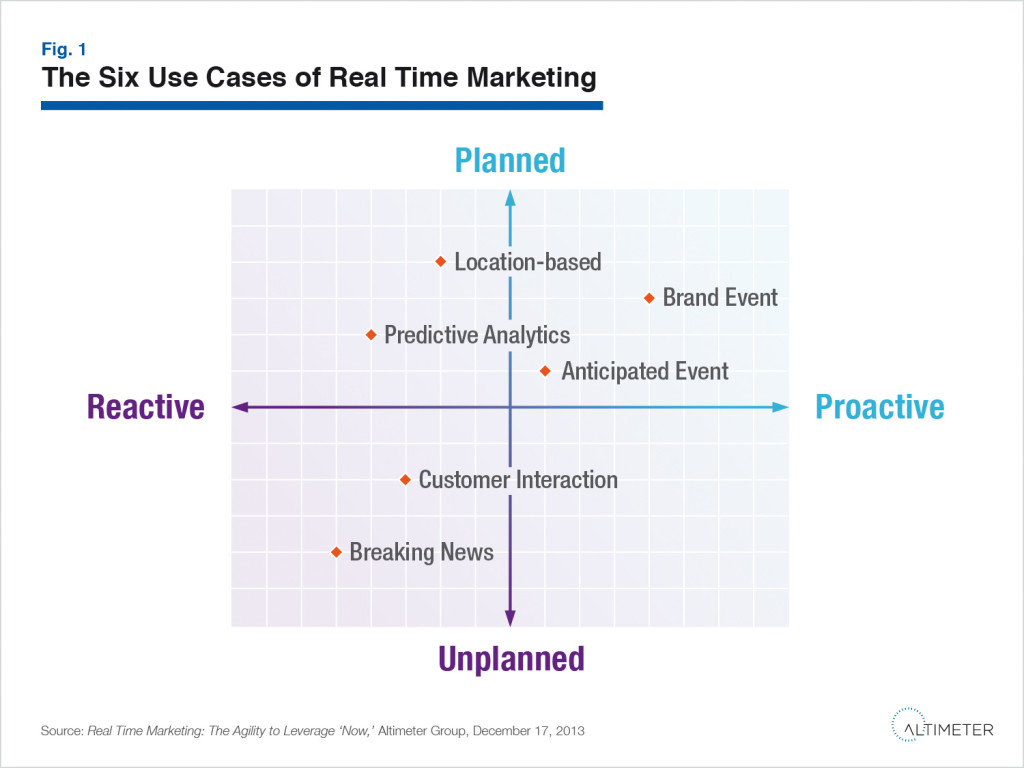"Don’t compete for the moment. Compete for meaning. If you compete for the moment you’re irrelevant." - Brian SolisReal-time marketing seems like a buzz word, but it also provides a real way to connect with your target audience. But before we dive into why it's so valuable, let's start with what it really is. Real-time marketing is just the practice of engaging your audience with content and ads that are relevant to an event, cultural phenomenon or moment currently happening. Real-time data is data that updates or is provided as those events or phenomenon are happening. For example, real-time data can be who is visiting your website at a specific time or what is trending around an event or in a specific market. How do these two relate? Well, real-time data helps power real-time marketing. We now have access to more data than ever before, including who clicks and share what, how visitors navigate sites and more. All in a matter of moments. So, how do you use this data and marketing to gain the biggest impact? Altimeter done some incredible research into the topic, dividing opportunities into six areas.
 We break down four specific use cases:
We break down four specific use cases: 1. Use real-time to react to crisis better and address consumer complaints.
Social media has provided the world instant access, which means brands must be paying attention more than ever. Real-time data lets you know when consumers are concerned and gives your brand the opportunity to respond faster. 72% of people who complain on Twitter expect a response within an hour. So, real-time data enables you to see when a customer has a complaint and respond quickly. We've seen this help brands, like Nike. In early 2014, the latest generation of our touch-screen command centres were installed at Nike’s European HQ. Situated in the centre of the Marketing Office, it is now an integral part of not only day-to-day brand monitoring but also product launches and crisis situations. Its key benefit to Nike is in increasing the ability to react and share social content and data quickly. Nike's team could then market in the moment to great effect. This became especially important during the launch of the England kit for the 2014 World Cup. As soon as the kit was launched, consumers started commenting very negatively on the price. The social team could instantly see this and identify key hot points and influencers in the conversation. They then brought the CMO into the conversation by inviting him to watch the live data. Using the insights, they rapidly came up with a strategy to neutralise dissenting conversation. All this was done in a matter of minutes without the need for reports. The speed of response was key in their team having an effective response.2. Use real-time to generate organic and natural dialogue with consumers.
Real-time marketing gives brands the opportunity to insert themselves into relevant conversations and generate a more organic dialogue with their target audience. Why does this matter? Well, we know that content marketing is an efficient funnel. Real-time marketing cuts the costs of content creation, providing that natural outlet. Some brands, like Oreo, have done this quite smartly, but with a savvy individual or team behind your social accounts, any brand can join the conversation.3. Use real-time to better understand what your customers want.
Who are your consumers and what are they interested in? People talk about what they love and what resonates with them. Real-time data helps you aggregate that data and dive deeper into it. We've seen this work with our friends at M&S. In January 2013, we installed several nine-sceen video walls in the main cafe and communal areas of M&S. Seeing what our team had created for Nokia, M&S wanted something that similarly engaged all their employees more with their customers. The idea was to create a culture of listening at M&S and to share actionable insights with the whole company. Immediately after our screens went live, the team who ran the M&S Confectionary saw that their Percy Pig product was frequently mentioned. They brought key decision makers over to the communal screens to share these insights from customers. This lead to a significant increase in Percy Pig related products being green-lit for development, many of which have become top sellers.4. Use real-time to maximise social campaigns.
Social data provides insight into your marketing efforts and the ability to optimize your campaigns in unique ways. Real-time provides you the data to see what components of your brand, service or product are hits with your audience. In early 2014, a major fashion brand began experimenting with our platform during Fashion Week. Buzz Radar was able to provide their marketing team with data around the most talked about products from their runway shows, as well as the models that resonated with their audience most. The social team was then able to pair the items to create stronger marketing assets based on their target consumers’ interests. These campaigns were able to be disseminated quickly following the shows, creating high uptick in demand and stronger campaigns overall. Real-time gives your brand the power to market smarter, better and on target.Nicky Yates Published on August 11, 2015 10:00 am

